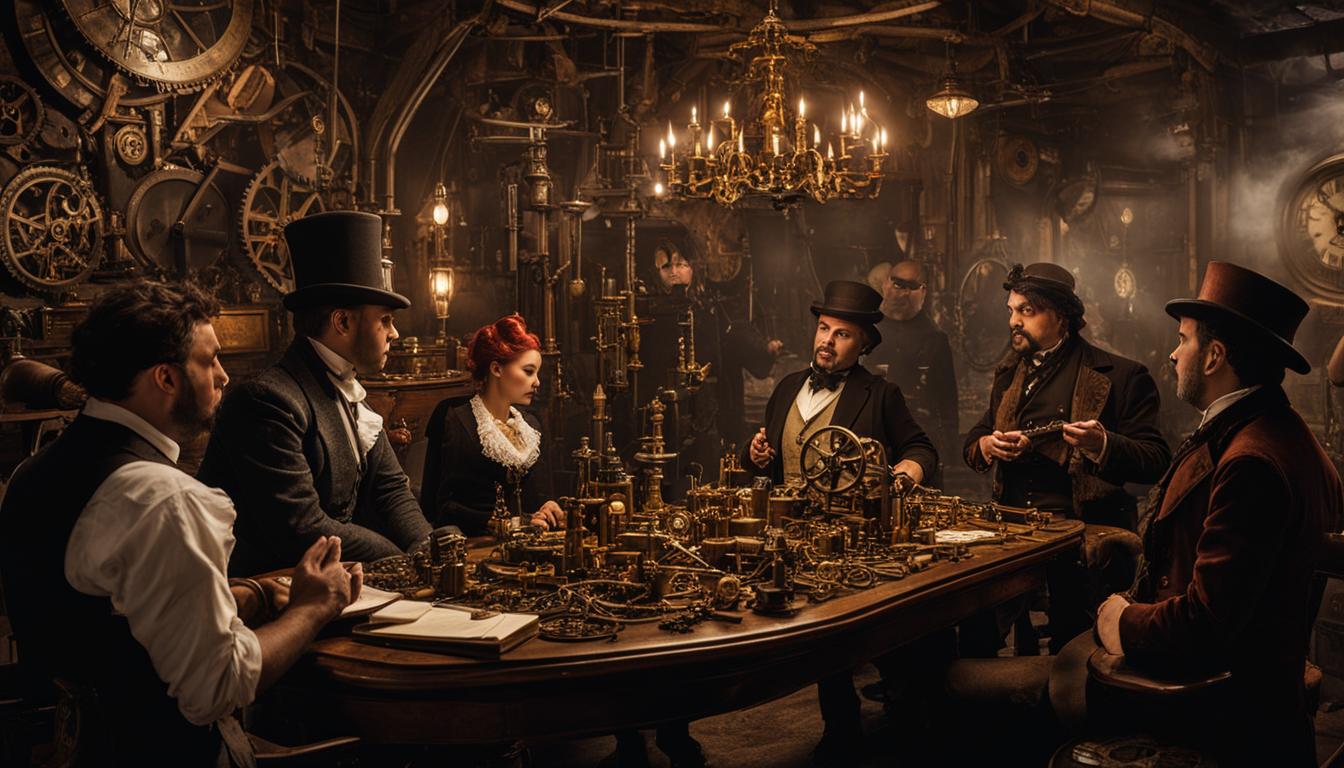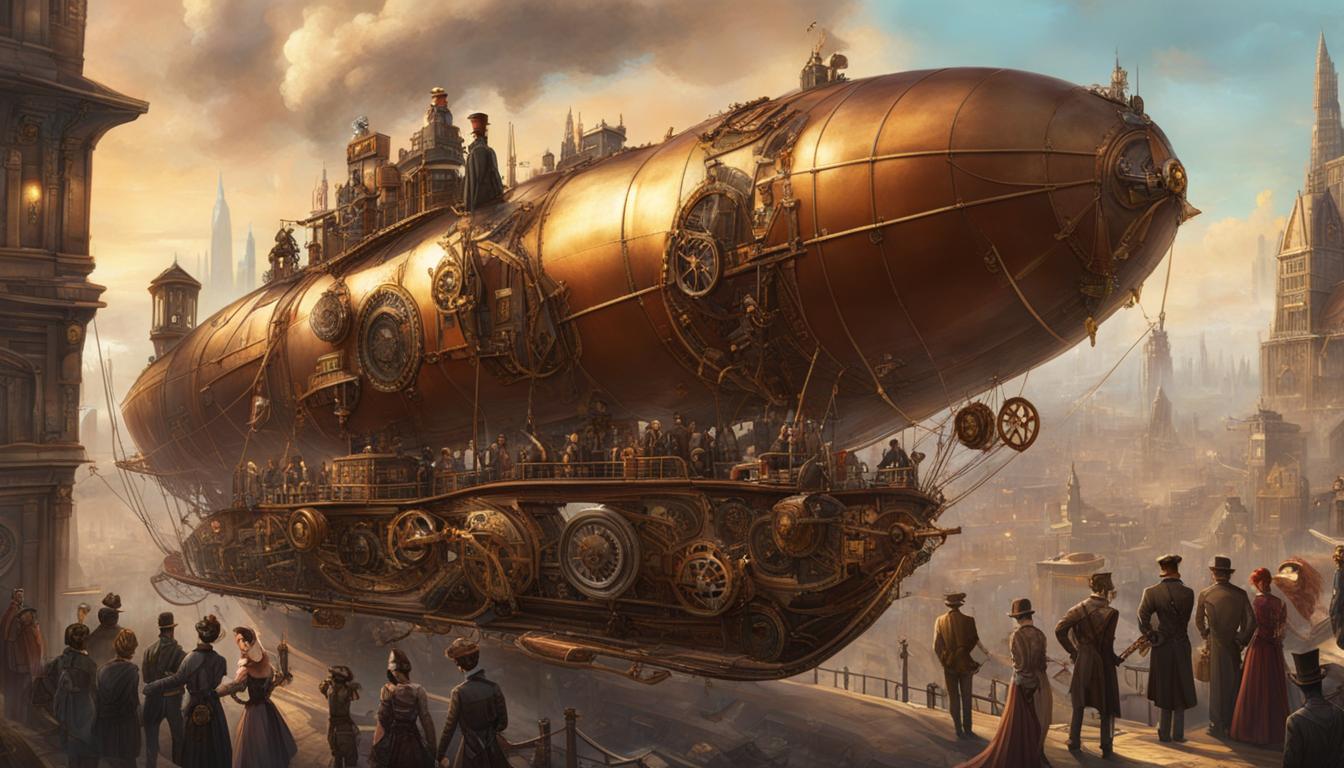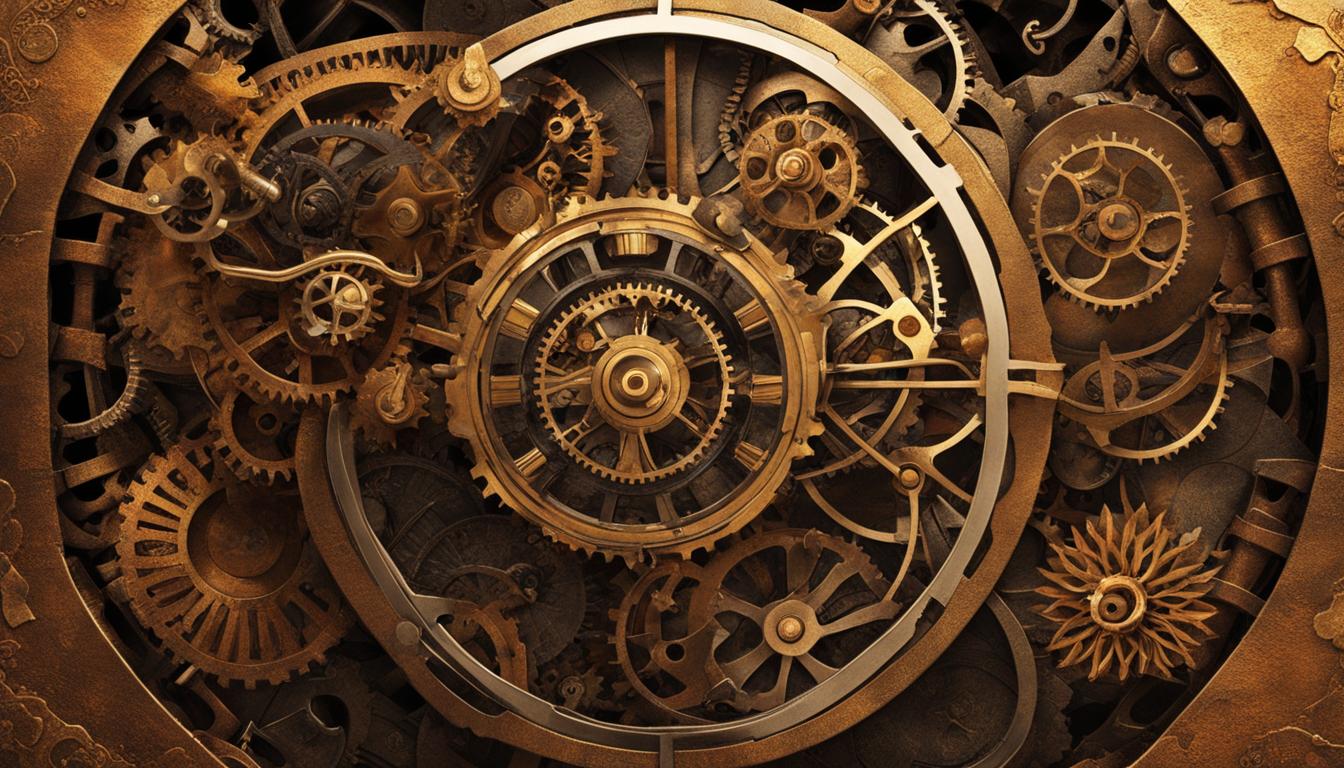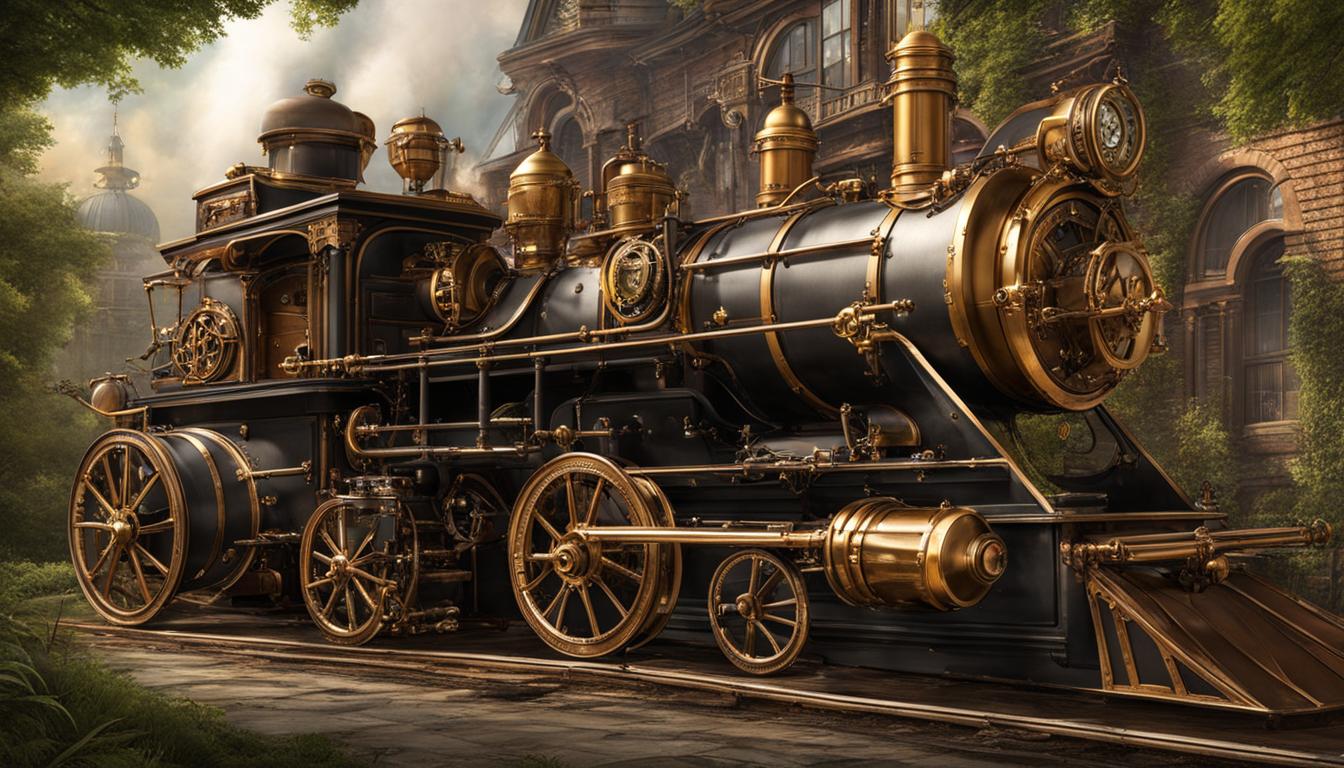Steampunk, a subculture that combines elements of Victorian aesthetics with futuristic technology, has ignited a fascinating array of philosophical debates within its community. These discussions delve into profound questions surrounding the relationship between technology and human agency, the rejection of mass production and consumer culture, the significance of the Victorian aesthetic, and the desire to redefine the connection between objects and users.
As steampunks gather in forums and conventions, they engage in passionate and thought-provoking conversations that challenge traditional notions of creativity, craftsmanship, and storytelling. These debates not only showcase the intricate nature of the steampunk ethos but also contribute to its vibrant and ever-evolving identity.
Key Takeaways:
- Steampunk community engages in philosophical debates surrounding technology and human agency.
- Rejection of mass production and consumer culture is a central theme in steampunk philosophy.
- The Victorian aesthetic serves as a metaphorical tool for exploring present-day concerns.
- Steampunk objects and machines emphasize tangibility and physicality.
- Personalized storytelling plays a vital role in the steampunk community.
Steampunk’s Rejection of Mass Production and Consumer Culture
Within the steampunk community, there is a passionate rejection of mass production and consumer culture. Steampunks believe that mass-produced items symbolize hegemonic systems and hierarchies of power, particularly capitalist ones. They advocate for the importance of artisan craftsmanship, valuing the inherent dignity of created objects. Steampunks see themselves as rebels against the mass market, choosing to rediscover the value of handmade, tangible items that possess a sense of uniqueness and individuality.
Steampunk’s internal discussions on ethics surrounding mass production and consumer culture are at the heart of the philosophical debates within the community. Through these debates, steampunks explore the societal implications of embracing mass-produced items versus supporting independent craftsmen. The goal is to challenge the dominant consumer culture and interrogate the values underlying it.
“We strive to resist the conformity and disposability of the mass-produced,” says Victor, a prominent figure in the steampunk community. “By embracing the craftsmanship of handcrafted objects, we not only reject the dehumanizing effects of mass production but also establish a deeper connection to the history and essence of the objects we create and collect.”
The rejection of mass production and consumer culture in steampunk sparks a variety of philosophical disagreements in the community. Some argue that the focus on handmade, tangible items excludes those who may not have the means or skills to engage in artisanal practices. Others believe that the rejection of consumer culture is a way to reclaim agency and resist the forces of capitalism. These ongoing debates stimulate intellectual growth and contribute to the vibrant and diverse nature of the steampunk subculture.
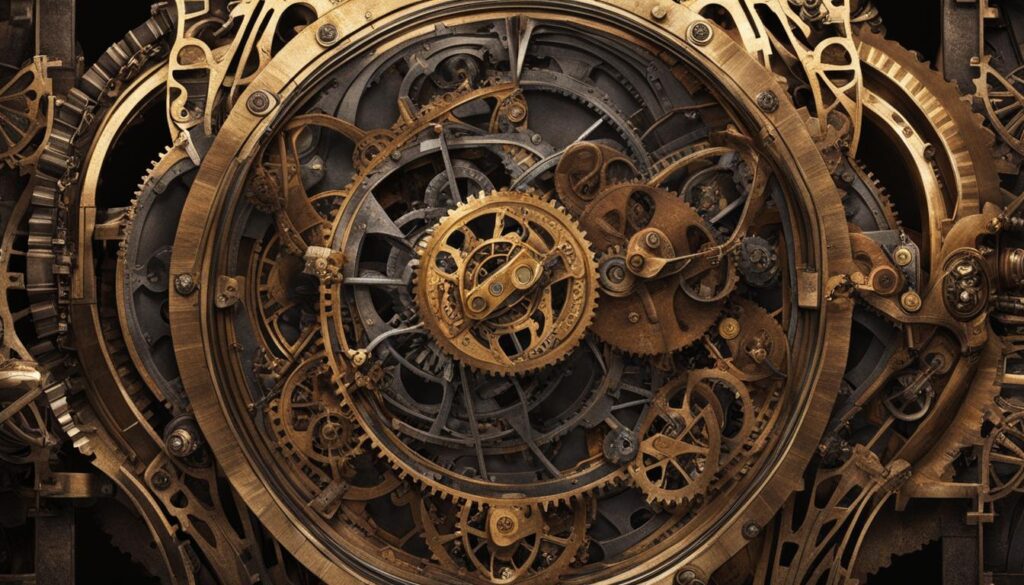
Table: A Comparison of Mass-Produced Items vs. Handcrafted Items in Steampunk Culture
| Criteria | Mass-Produced Items | Handcrafted Items |
|---|---|---|
| Production Process | Factory assembly line | Artisan craftsmanship |
| Uniqueness | Mass-produced replicas | One-of-a-kind creations |
| Connection to History | Generic and detached | Personal and evocative |
| Environmental Impact | Mass consumption and waste | Sustainable production |
| Cultural Value | Disposable and replaceable | Long-lasting and cherished |
The Victorian Aesthetic as a Philosophical Tool
The Victorian design aesthetic is a central topic of debate within the steampunk community. It serves as a powerful tool for exploring philosophical ideas and challenging our current relationship with technology. Steampunks embrace the visual elements of brass, wood, ironwork, copper, and clockwork, using them as metaphors to symbolize labor, agency, and craftsmanship. This revisionist aesthetic acts as a bridge between the past and present, allowing steampunks to examine the implications of technology in our society.
By incorporating the Victorian aesthetic, steampunks engage in a speculative exploration of the past. They question the consequences of the industrial revolution and reimagine what could have been if technology had developed differently. The aesthetic serves as a visual shorthand, encapsulating complex ideas and inviting contemplation about the role of technology in shaping our lives and identities.
Steampunk artist and philosopher, Amelia Blackwood, eloquently captures the significance of the Victorian aesthetic, saying, “When we engage with the aesthetic of the past, we are not merely indulging in nostalgia. We are actively reimagining our present and future, challenging the assumptions and norms of our time.”
This controversial topic sparks passionate discussions within the steampunk community. Some argue that the Victorian aesthetic romanticizes a problematic era and fails to address the social inequalities and injustices of the time. Others view it as a catalyst for critical thinking, allowing us to examine the consequences of progress and the potential for alternative futures.
Central Debates in Steampunk Literature
The Victorian aesthetic is a recurring theme in steampunk literature. Authors often use it to explore complex ideas about technology, society, and individual agency. In works like “The Difference Engine” by William Gibson and Bruce Sterling, the aesthetic serves as a backdrop for examining the impact of information technology on social structures.
As steampunk literature continues to evolve, the debate around the Victorian aesthetic remains at the forefront. Authors and readers alike engage in thoughtful discussions, questioning the assumptions embedded within the aesthetic and exploring its potential for subversion and social commentary.
| Pros | Cons |
|---|---|
| Acts as a powerful metaphor for labor, agency, and craftsmanship. | Romanticizes a problematic era and fails to address social inequalities. |
| Invites contemplation about the implications of technology in our society. | May reinforce outdated gender roles and colonial attitudes. |
| Encourages critical thinking and reimagining of our present and future. | Can overshadow the social and political aspects of steampunk. |
As with any philosophical debate, the arguments surrounding the Victorian aesthetic in steampunk literature are multifaceted, nuanced, and ongoing. They contribute to the vibrancy and thought-provoking nature of the steampunk subculture, fostering an environment of intellectual exploration and creative expression.
Heated Discussions in the Steampunk Community: The Relationship Between Technology and Human Agency
One of the most controversial and ongoing debates within the steampunk community revolves around the relationship between technology and human agency. Steampunks passionately argue that the sleek and impersonal nature of digital technology diminishes the sense of adventure and control that they crave. They believe that steampunk machines, with their physical, tangible, and intentionally imperfect designs, offer a unique accessibility and individuation that is lacking in modern devices.
The discussions on technology and human agency delve into the philosophical implications of our interaction with technology. Steampunks argue that the appreciation for the physical world and the inherent danger of engaging with volatile objects foster a deeper connection to the material realm. By rejecting the mass-produced and disposable nature of contemporary technology, steampunks seek to regain a sense of agency and autonomy in their interactions with machines.
“Steampunk machines embody a sense of vulnerability and imperfection that is often missing in today’s technology-driven world,” states Jessica Mason, a prominent member of the steampunk community. “They remind us that our relationship with technology should be tangible, hands-on, and experiential. It’s about forging a connection, not just pressing buttons.”
These ongoing debates in steampunk forums showcase the community’s dedication to challenging the status quo and redefining the role of technology in our lives. The discussions continue to shape the philosophy of steampunk, driving its exploration of the intricate connection between technology and human agency.
| Pros | Cons |
|---|---|
| Reclaims a sense of adventure and control | Rejects mass-produced and disposable technology |
| Offers a unique sense of accessibility and vulnerability | Can be seen as impractical and overly nostalgic |
| Fosters a deeper connection to the material realm | May not be suitable for all individuals or industries |
Core Debates in Steampunk Circles: The Tangibility of Steampunk Objects and Machines
Steampunk objects and machines are at the heart of core debates within the steampunk community. These discussions revolve around the tangibility and physicality of steampunk creations. Steampunks value the imperfections, chaos, and obsolescence that are inherent in their handmade creations. They believe that these tangible and sometimes bulky machines offer a unique connection to the material realm.
The appreciation for the physical world and the inherent danger of interacting with volatile objects fosters a deeper connection between the user and the steampunk creations. Steampunk enthusiasts argue that the tactile experience brings a sense of authenticity and individuality that is lacking in the sleek and streamlined devices of the digital age. Through their discussions, they seek to redefine the relationship between humans and technology, emphasizing the importance of physical interaction and the sensory experience.
Steampunk objects are more than just aesthetic pieces; they are vessels of imagination and adventure. The physicality of these creations encourages exploration and experimentation, allowing individuals to become active participants in the imagination-driven world of steampunk.
The Steampunk Manifesto: The Power of Tangibility
One of the central arguments within the tangibility debate is outlined in “The Steampunk Manifesto” by Jake von Slatt. He highlights the power of tangibility in the steampunk world and argues that the physical nature of steampunk objects invites curiosity, exploration, and a sense of wonder that stimulates the imagination. According to von Slatt, the interaction with tangible objects fosters a deeper connection to the past, present, and future, providing a sense of agency and control.
| Steampunk Objects | Digital Devices |
|---|---|
| Embrace imperfections and chaos | Sleek and streamlined |
| Encourage exploration and experimentation | Designed for efficiency and ease of use |
| Promote sensory experiences | Focus on visual and auditory stimulation |
| Invite personalization and individual expression | Designed for mass consumption and uniformity |
Through these debates, steampunks delve into the philosophical implications of tangibility and physicality in our increasingly digital world. The discussions not only provoke thought but also inspire creativity and innovation within the steampunk subculture. Whether it’s the intricate gears and exposed mechanisms of a steampunk watch or the clunky yet captivating contraptions, the tangibility of steampunk objects continues to fuel the imagination of enthusiasts worldwide.
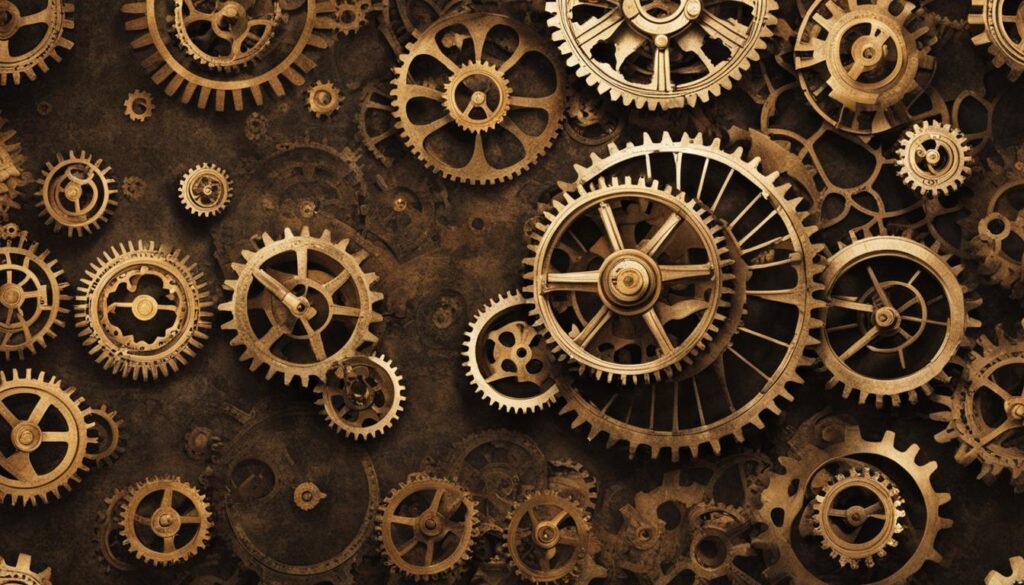
Table: The Importance of Personalized Storytelling in Steampunk
| Benefits | Impact |
|---|---|
| Empowers individuals | Encourages agency and self-expression |
| Fosters creativity | Inspires innovation and experimentation |
| Builds community | Strengthens connections and fosters collaboration |
| Challenges the status quo | Questions established norms and encourages critical thinking |
| Provokes philosophical discussions | Explores ethics, identity, and the human experience |
The Importance and Misunderstanding of Definitions in Steampunk
One of the key debates within the steampunk realm revolves around the importance and misunderstanding of definitions. Within the community, there are differing opinions on whether strict boundaries and definitions are necessary or if they stifle creativity and individual expression. Some argue that defining what constitutes steampunk restricts the subculture’s potential for growth and evolution, as it could exclude innovative ideas and interpretations that deviate from traditional norms. On the other hand, proponents argue that definitions are essential in allowing outsiders to understand and engage with the subculture, preventing it from becoming an ambiguous catch-all term.
Those who advocate for a broad definition believe that steampunk should be an inclusive and welcoming space, where different expressions and aesthetics can coexist. They argue that focusing too much on rigid definitions risks turning steampunk into an exclusive club, shutting out individuals who may not fit into a narrow mold. This perspective emphasizes the fluid nature of steampunk and encourages a diverse range of interpretations and ideas.
However, there are also valid concerns raised by those who support more precise definitions. They argue that a clear definition helps establish a shared language and understanding within the community, fostering a sense of unity and identity. Furthermore, having well-defined parameters enables individuals to distinguish between steampunk and unrelated genres, preventing dilution and misrepresentation of the subculture. By establishing boundaries, enthusiasts can better navigate and explore the various facets of steampunk, ensuring its longevity and integrity.
The Misunderstanding of Definitions and the Fear of Exclusion
One of the primary fears associated with strict definitions is the potential exclusion of individuals who do not conform to a predetermined set of criteria. This fear stems from the belief that steampunk’s strength lies in its openness to multiple interpretations and expressions. Critics argue that imposing rigid definitions risks alienating creative individuals who may have innovative ideas that push the boundaries of traditional steampunk aesthetics.
However, it is essential to note that defining a subculture such as steampunk does not necessarily mean stifling creativity or enforcing narrow boundaries. Definitions can serve as a foundation for understanding and engaging with the core principles and aesthetics of steampunk while still allowing for individual expression and innovation. They provide a framework within which creativity can flourish, offering a common ground for enthusiasts to connect and share their passion.
In conclusion, the importance and misunderstanding of definitions are ongoing debates within the steampunk community. While some argue for a broad and inclusive definition to encourage creativity and diversity, others emphasize the need for clear boundaries to preserve the subculture’s integrity and identity. Finding a balance between these perspectives is crucial in fostering a vibrant and welcoming community that embraces both tradition and innovation.
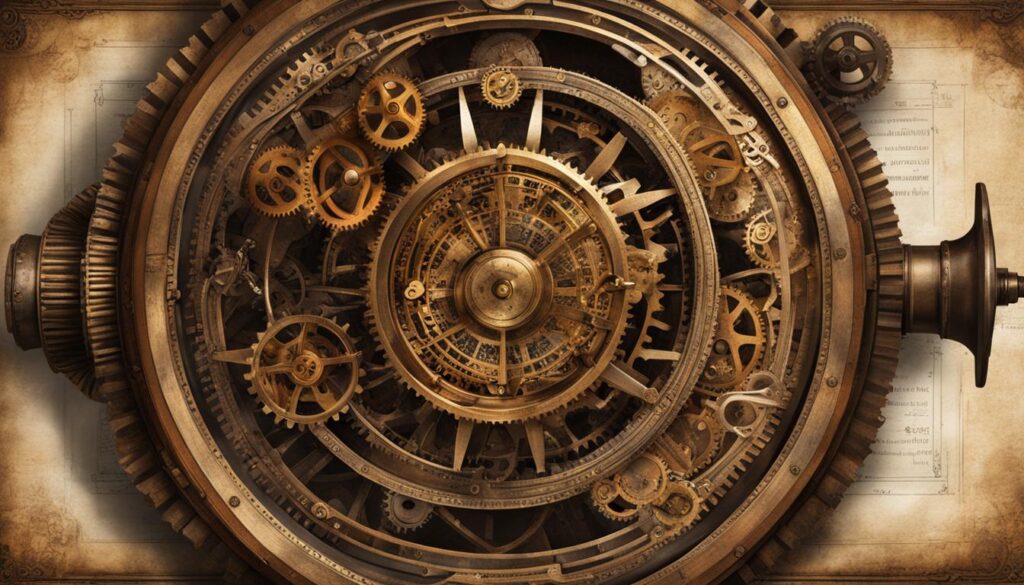
Conclusion
The steampunk community is a hotbed of historical debates and philosophical discussions. Steampunks engage in passionate conversations about the rejection of mass production, the significance of the Victorian aesthetic, the relationship between technology and human agency, and the importance of personalized storytelling. These controversies contribute to the vibrant and thought-provoking nature of the steampunk subculture.
Through these discussions, steampunks challenge societal norms and explore alternative ways of thinking about the world. They question the hegemonic systems and hierarchies of power embedded in consumer culture, opting instead for the inherent dignity of handmade, tangible objects. By embracing the Victorian aesthetic, they symbolically encode present-day concerns on labor, technology, and agency, offering a speculative window into the past to examine our present reality.
Steampunks also delve into the tangible nature of their creations. They celebrate imperfections, chaos, and obsolescence, highlighting the contrast between their physical machines and the sleekness of digital technology. By emphasizing the importance of tangibility and physicality, steampunks argue for a deeper connection to the material world and a unique sense of accessibility and individuation.
Lastly, steampunks value personalized storytelling as a means of reclaiming creativity and reshaping the user-object relationship. They reject the homogenization of technology and invite others to engage in community-driven projects that foster individual expression. This emphasis on personalized storytelling spurs curiosity, innovation, and passionate discussions within the steampunk realm.
FAQ
What are some of the key philosophical debates within the steampunk community?
Steampunk enthusiasts engage in discussions on topics like the relationship between technology and human agency, the rejection of mass production and consumer culture, the significance of the Victorian aesthetic, and the importance of personalized storytelling.
Why do steampunks reject mass production and consumer culture?
Steampunks believe that mass production symbolizes hegemonic systems and capitalist hierarchies of power. They emphasize the value of artisan craftsmanship and the dignity of created objects, resisting the mass market and seeking to rediscover the worth of handmade, tangible items.
How does the Victorian aesthetic contribute to the philosophical debates within steampunk?
Steampunks embrace the Victorian aesthetic of brass, wood, ironwork, copper, and clockwork, as it symbolizes labor, agency, and craftsmanship. By incorporating this aesthetic, they engage in a speculative exploration of the past to challenge our current relationship with technology and examine present-day concerns on labor and agency.
What is the relationship between technology and human agency in steampunk?
Steampunk enthusiasts aim to reclaim a sense of adventure and control that they perceive as lacking in digital technology. They argue that steampunk machines, with their physicality and imperfections, offer a unique accessibility, vulnerability, and individuation. These discussions on technology and human agency are at the core of the steampunk philosophy.
Why do steampunks value the tangibility of objects and machines?
Steampunks appreciate the imperfections, chaos, and obsolescence in their creations, which serve as a contrast to the sleek devices of the digital age. They believe that interacting with tangible and physical machines fosters a deeper connection to the material realm and a greater appreciation for the physical world.
How does personalized storytelling play a role in steampunk?
Steampunk enthusiasts emphasize personalized storytelling and the sharing of knowledge and creativity. They reject the homogenization of technology and consumer culture, encouraging individual expression and resisting restrictions on access to and understanding of devices. By reclaiming the creative process, they redefine the relationship between the user and the object.
Why are definitions important in the steampunk community?
The steampunk community debates the importance and misunderstanding of definitions. Some argue that strict boundaries stifle creativity and individual expression, while others believe that definitions allow outsiders to understand and engage with the subculture. These discussions shed light on the complexities surrounding the definition and identity of steampunk.

